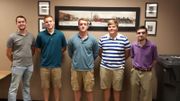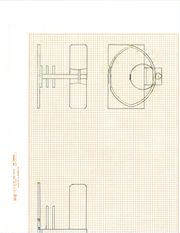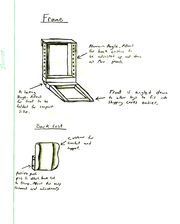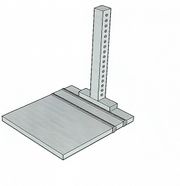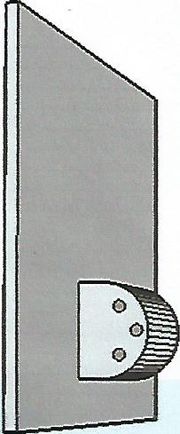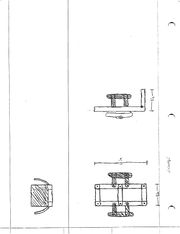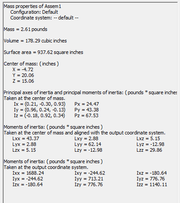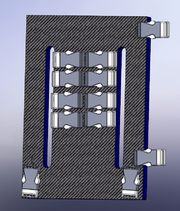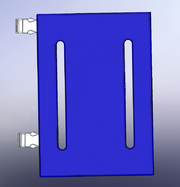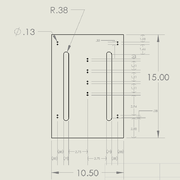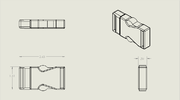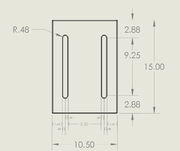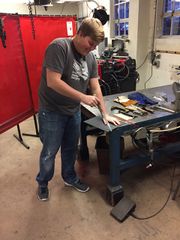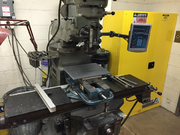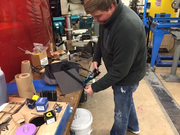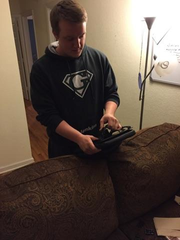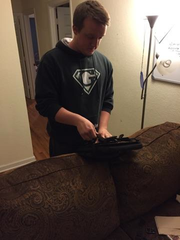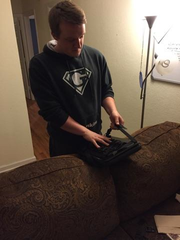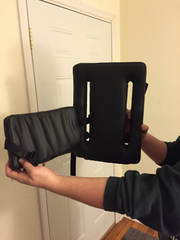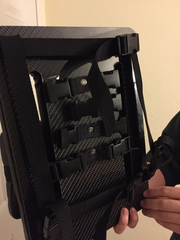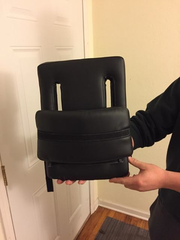Shopping Cart Seat F14
Contents |
Abstract
Ace is a child that is 1-year-old, and cannot sit straight up on his own.
Team members
- Brandon Harms
- Kaleb Stephens
- Hunter Staggs
- Dylan Mccracken
- Austin Jenkins
Problem Statement/overview of the need
Ace cannot sit up straight without assistance. This makes tasks like going shopping difficult for the family. Ace must use his arms and plant them out to his side to keep from falling over. Because of this, he cannot sit up straight when he is seated in a shopping cart. The mother must place him in a car seat inside the shopping cart, taking up a large amount of room. She has also asked if the team could make the seat versatile enough to be placed in other seats, such as: restaurant high chairs, playground swings, and toy “carts.”
Design Specifications
- Weight should be less than 10 pounds.
- When folded up, the overall dimensions should around 12”x12”x6”.
- Ace roughly measures 7” in width, 6” from his knee to hip, and 12” from bottom to shoulders.
- Must be usable in a shopping cart’s existing seat.
Background research
Ace’s mom currently has a mini pacer that works well for him. However, it is a device that is made to help him learn how to walk. It is far too bulky for a shopping cart, and is not designed for it. The seating inside the pacer works well, however there is no way to mount it with stability in a shopping cart seat. This is the only design that is even close to what Ace needs.
Conceptual Design
The seat should be able to support Ace so that he can sit in the shopping cart seat. The team also concluded that it needed to be lightweight, and as small as possible. This is so Ace’s mom can easily haul the seat around to where she goes. The team also tried to incorporate the idea of being able to mount the seat in another locations besides a shopping cart seat.
Design Concept 1
This is a folding bottom aluminum chair. The key features of this concept are the large foam pad that would wrap around Ace's body, and the two small straps around the bottom that could be used for alternative mounting methods. Not pictured in this concept is an optional locking pin that will allow you to rigidly fix the seat relative to the back. Ideally, this could be constructed to less than 10 pounds, and allows for ease of movement.
Design Concept 2
This would be able to fold up, be versatile and easy to adjust. Both the back and seat are padded. The back would be able to adjust up and down with a spring pin. Instead of having something to mount it, it would be able to sit in the shopping cart seat. Attach to the back rest of the seat would be a strap that could be brought around to the front to wrap around Ace.
Design Concept 3
The top piece can be attached to the base via pins. The top can be adjusted to a different angle to allow for more comfort. Both top and bottom will be padded. The bottom will have a double hinge to allow it to go behind the back support for ease of carrying and storage. It will have a sliding pin underneath that will lock the seat in place. The base will have an arm that extends up with multiple holes for the top part to pin into.
Design Concept 4
Two aluminum bars connected by three shorter aluminum bars that has a hinge that lowers an aluminum plate. Coming off the two main aluminum bars are two straps that velcro in the middle that fasten Ace to the chair. On the back of the chair are straps that can hook onto multiple surfaces.
Evaluate concepts/select candidate
CONCEPT OF EVALUATION (RATING 1 OUT OF 5)
| CONCEPTS | DESIGN 1 | DESIGN 2 | DESIGN 3 | DESIGN 4 | |
|---|---|---|---|---|---|
| STRENGTH | 2 | 5 | 4 | 3 | |
| SIZE | 4 | 2 | 4 | 2 | |
| WEIGHT | 4 | 2 | 3 | 3 | |
| VERSATILITY | 3 | 3 | 4 | 3 | |
| ADJUSTABILITY | 3 | 3 | 5 | 2 | |
| TOTAL 25 POSSIBLE POINTS | 16 | 15 | 20 | 13 |
The winner is design 3!
Detailed Design
- After our first presentation, we looked over the feedback given by our peers and professor. We talked about some key points our peers had brought up during our presentation for Design #3. We took these into consideration and started on our design to present to Ace's mom. After discussing with her, we came up with the following design.
Structure
- We decided to go with a carbon fiber plate for our main structure. We discarded the idea of moving the plate vertically on a support beam. Instead we decided to make the plate an overall height that should last long enough for Ace to develop enough strength to hold himself upright on his own. After talking with Ace's mom, we concluded that a base plate would not be necessary.
- The overall dimensions of the plate will be 15"x10.5"x.125".
- The plate will have two slits in it to allow the "arms" to come through from the back.
Cushion
- Ace's mom told us she would prefer to have the vinyl for the material on the cushion. This would allow for easier cleaning and no staining. Inside we will have a nice memory foam cushion about one inch thick to provide comfort for Ace to lean into. The cushion itself will also have slits for the arms. It will be the overall dimension as the plate. On the reverse of the cushion, velcro will be attached so that it can be taken off the plate to allow for easier cleaning.
Arms
- The supporting arms to hold Ace upright will resemble backpack straps. They will be made of vinyl as well with some cushion in them to make them comfortable. On the part that wraps around Ace, a male and female buckle will be stitched on to the arms to secure Ace in. The buckles will be adjustable in front to allow for more comfort. On the rear of the arms, another set of male ends will be placed on both arms. These male buckles will snap into female buckles already positioned on the rear of the plate. The females will be riveted into the plate. There will be four sets of these female ends to allow for adjustment as Ace grows taller (provided he still needs the back).
Straps
- We decided to go with four sets of buckle/strap systems to secure the plate to different seats. There will be two sets of horizontal and two sets of vertical buckles. They will be positioned at key areas as shown so that hopefully the back can be strapped in almost any seat. The buckles will be able to be tightened down to allow for proper securement to the different seats.
Analysis
Engineering analysis 1
- We calculated a "worst case scenario" of the max bending stress that could be placed on the plate itself.
- We figured the scenario as the bottom six inches of the plate were fixed. We put a distributed load of 75 lbf on the plate (to simulate a fairly large child leaning back on it). As you can see on the picture, the plate would be fine with a factor of safety around 3. Even with abnormal load on this plate, it will not break under the stress.
- This is a link to the plate: http://www.mcmaster.com/#standard-carbon-fiber-sheets/=u6mmn2.
- If you so desire here is a link for the mechanical properties of the plate: http://www.mcmaster.com/#8549kac/=u6mmr1.
Engineering analysis 2
- Our 2nd analysis was to find the max force we think could be placed (worst case scenario) on the buckles stitched into the arms. The manufacturer rated that it would take approximately 110 lbf (489 N) to break the buckles apart.
We will figure that the maximum mass he could be while using this seat is approximately 15 kilograms. To find the maximum force that he would apply on the buckles, we will have take a short journey back to Dynamics. Recall that F = m * a. Let us assume that he is strapped into his toy cart and his sister is pushing him around. She starts running with him at a constant velocity 2 m/s and then stops quickly. We will assume that this deceleration took place over a time interval of one second. Let us assume the buckles experience one full G of acceleration. From our previous formula:
F = (15kg) * (9.81 m/s^2) = 147 N.
So obviously, this is nowhere near the 489 N needed to break the buckles.
- Here is a link to the buckle: http://www.plastic-buckle.com/p006-side-release-buckle.aspx
Engineering analysis 3
- Our 3rd analysis was a weight calculation. Our initial goal was to be under 10 pounds.
- We chose carbon fiber so that we could keep our weight down and keep our structural rigidity and strength.
- The buckles brought a strong but light option for securing everything.
CAD Drawings
Bill of Materials
MATERIALS
| ITEM | DESCRIPTION | DIMENSIONS | MANUFACTURER | PART NUMBER | QUANTITY | PRICE PER PART($) | PRICE($) | |
|---|---|---|---|---|---|---|---|---|
| Carbon Fiber Plate | Main Support | 12" x 24" x 0.125" | Dragon Plate | 1 | 133.50 | 133.50 | ||
| Plastic Side Release Buckle | Buckle | 2 5/8" x 1 1/4" x 15/32" | Plastic-Buckle.com | N/A | 12 | 0.49 | 5.88 | |
| Nylon | Straps | 25' x 1" x 0.0625" | McMaster-Carr | 8852T62 | 25 | 0.25 | 6.25 | |
| Vinyl | Cushion Material | N/A | Broadway Upholstery | N/A | 1 | (included upholstery price) | N/A | |
| Rivets | Secure the buckles to plate | N/A | McMaster-Carr | 97525A415 | 1 | 8.77 | 8.77 | |
| Velcro | Secure foam pad to plate | 5' x 1" x 0.125" | McMaster-Carr | 9723K14 | 1 | 7.94 | 7.94 | |
| Upholstery Work | Cushion, Vinyl, Arms | N/A | Broadway Upholstery | N/A | 1 | 260.00 | 260.00 | |
| Total Price | 422.34 |
Fabrication Process
Photos of Completed design
Instructions for safe use
- Do not use the device unless supervised by an adult that has been fully understood the safe use of this product.
- Use the buckles on the back solely for strapping the seat into the seat. Tighten buckles down to ensure a snug fit.
- Adjust arms as needed to better fit the child. Tighten the arms around the child so that he will remain comfortable.
- Keep buckles not being used snapped in to others to ensure no child will try to chew or swallow them.
- Make sure that seat is securely strapped in before securing child against the seat.
Summary and Conclusions
- Overall, this was a fun project that presented quite a few challenges. All of the group worked hard together to get this done to the best of our abilities. Although we encountered numerous problems with an upholstery company, we were able to overcome the problems and make the seat functional.
- The seat is neither bulky nor heavy, ensuring that it will be easy for the mother to carry anywhere she needs to go.
- The group would like to thank Dr. Canfield and the EIME project for allowing us the opportunity to gain real world experience. It was a very enlightening experience and all of the group learned much.
